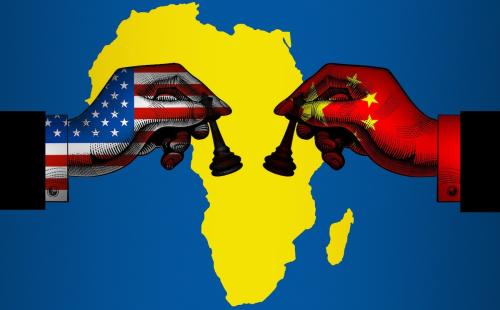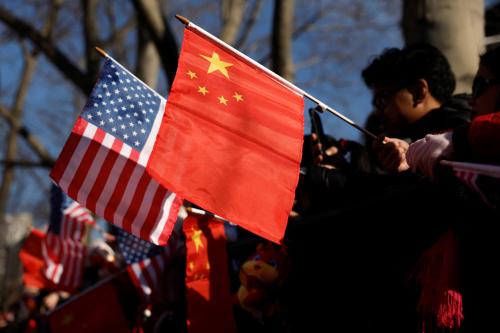On May 17, the Group of Experts appointed over a year ago by NATO Secretary General Anders Rasmussen and chaired by former Secretary of State Madeleine Albright presented its final report on the new Strategic Concept for the Alliance. Entitled “NATO 2020,” the document is meant to lay the groundwork for preparation of the Strategic Concept, which is to be approved by NATO leaders at the Lisbon Summit next November. Transatlantic allies will have the opportunity to update the Alliance’s strategic doctrine to address the challenges to Western security for at least the next ten years. The last Strategic Concept was approved in 1999, before 9/11, much of NATO’s enlargement, the Afghanistan War, and the multiple transatlantic tensions that developed during the Bush years.
The report is comprehensive and detailed. Its recommendations, however, do not always match the measure of vision and boldness that many think is needed to invigorate NATO and renew its sense of purpose. Visionary or provocative proposals floated in recent months in expert and political circles, such as opening NATO’s door to Russia or revising NATO’s nuclear deterrence policy, are not discussed. As a consensus document drafted by twelve distinguished personalities with long-standing ties to the Alliance, “NATO 2020” is balanced and moderate in its language and recommendations. It is understandably wary of plans for transformation that are too radical or “outside the box,” especially if they imply a reduction of NATO’s role or a reconsideration of its mission as traditionally understood.
Despite this and other inherent constraints, “NATO 2020” indeed contains some important reflections and proposals. The evolution of thinking on transatlantic relations, moreover, can be appreciated by looking at what the report prioritized and where it paid only passing—or no—attention.
Underpinning the entire effort seems to be the attempt to overcome some of the thorny issues which have undermined consensus and cooperation within the Alliance in recent years. The report tries to reconcile differences through the identification of more advanced solutions or new concepts.
NATO’s Role and Projection
A debate that had deeply divided NATO during the Bush years was whether the Alliance should ‘go global,’ becoming the hub of international security in an increasingly globalized world where security threats are often unconventional in nature and transnational in scope. In fact, the Bush administration curiously and disturbingly oscillated between sidelining NATO in favor of unilateralism and “coalitions of the willing” and endeavoring to build the Alliance up through further enlargement, further expansion of tasks, and further widening of its scope of action. Europeans, for their part, never felt comfortable with the vision of NATO as a global policeman (seen as supplanting the U.N.), or with a ‘Global NATO,’ as in a world-wide alliance of democracies. Europeans feared that they could end up losing their exclusive link with Washington. Many Europeans, moreover, resisted the employment of NATO in far away missions. Afghanistan itself demonstrated European solidarity with the United States much more than a common vision of NATO as an expeditionary alliance engaged in the fight against global threats.
The report attempts to solve these dichotomies – or at least bridge them. In a rare example of strategic honesty, “NATO 2020” states clearly that NATO is a “regional, not a global organization,” “its resources and authority are limited,’’ and it “is by no means the only answer to every problem affecting international security.” This sounds like a revision of the U.S. position, and it will most likely be met with favor by Europeans. The report also strongly re-affirms NATO’s traditional role as a defensive alliance, whose core commitment is the safeguard of the political independence, security, and territorial integrity of its members. At the same time, one of the document’s central points is that, in the changed world of the 21st century, the Allies’ re-commitment to Article 5 on collective defense will not be complete if NATO is unready to meet threats “regardless of their point of origin,” even if this means expanding the definition of defense to include missions outside the traditional limits of the Euro-Atlantic area. The subtitle of the report captures this link, calling to combine ‘assured security’ with ‘dynamic engagement’.
In order to create a broad consensus on what the threats to the security of Allies are or may become in the future, “NATO 2020” suggests making more regular and effective use of inter-allied consultation under Article 4 of the North Atlantic Treaty. Operations outside Alliance borders, moreover, should follow clearer and stricter guidelines. The general principle should be that “NATO’s commitments should never exceed what the Alliance can do.” Among the lessons that can be drawn from the difficult and still highly uncertain mission in Afghanistan (to which the Group of Experts curiously dedicated only one page out of fifty) are the needs for advance planning and common training, stronger command structures, and better coordination and coherence of efforts through limiting national caveats on use of forces.
NATO’s Partnerships
Coupled with the suggestion to solve the age-old out-of-area dilemma by further updating the approach to defense is a new emphasis on partnerships – perhaps the most creative element of the report. The starting point is that NATO has many more partners than members and that some of them, such as Australia, New Zealand and Japan, have contributed to the Alliance’s latest missions, including Afghanistan, more substantially than some Allies. Partnerships have also been developed and sometimes upgraded since the 1990s with a plethora of countries in Eurasia, the Mediterranean and the Middle East, giving birth to multiple typologies of interaction and varying degrees of cooperation.
In recognition of NATO partners’ growing role and value, and given the limits of NATO enlargement policy, “NATO 2020” innovatively proposes to include the management of such relations among NATO’s ‘core tasks.’ This is far from recommending a new monolithic, one-size-fits-all approach to NATO’s partnerships. The report stresses instead the need for even greater differentiation coupled with an expansion of partnership activities and greater involvement of partners in planning activities. The latter seems particularly imperative in the case of ‘operational partners,’ such as Australia in Afghanistan, which have to date participated in highly demanding and risky NATO missions with no say whatsoever in the definition of the mission’s objectives.
The Relationship with Russia
While this re-conceptualization of NATO’s global role has clear value, other areas of the document appear weaker and less creative, sometimes shying away from the political issues involved. “NATO 2020” is in line with the Obama administration’s reset policy with Russia. It advocates for reassurance as well as active engagement with Moscow. Most likely due to the position of Central and Eastern European members (participating for the first time in the drafting of a Strategic Concept), the document is fairly conservative in its approach. Recommendations range from expanding the agenda for NATO-Russia consultation to making full use of the OSCE toolbox. The report does not endorse more ambitious plans to reconsider the role of existing security institutions with a view to putting in place a new European security architecture, as long advocated by Moscow. After all, while leaving the door open for engagement with Russia on such issues, the Obama administration has already made clear that it does not see the need for new binding instruments or institutions, and has rejected Russian President Medvedev’s most recent proposal for a European security treaty. Even the more limited proposal to actively involve Russia in the new plans for missile defense, strongly put forward by Secretary General Rasmussen himself at the Brussels Forum in March under the slogan of “one security roof,” does not seem to have been seriously picked up by the Group of Experts. The report limits itself to endorse Obama’s new phased, adaptive approach to ballistic missile defense as allowing for ‘concrete security cooperation’ with Russia.
NATO and the EU
Perhaps even weaker is the part of the document focusing on the European Union. “NATO 2020” indeed underlines that the European Union is a ‘unique’ and ‘essential’ partner of the Alliance. This observation, however, is not supported by particularly innovative proposals on how to make NATO-EU cooperation more effective. The report recognizes that the post-Lisbon European Union has the instruments and authority, at least on paper, to become a security provider as opposed to security consumer in Europe. The framework in which the discussion is developed, however, still seems to be the traditional one, according to which the EU does the civilian side while NATO and the United States deal with military matters.
Ukraine and Georgia
When it comes to the countries of Eastern Europe and the Caucasus, the report recognizes the limits of NATO’s ‘open door’ policy but does not explore non-NATO alternatives, such as EU partnerships or further EU enlargement. The report offers no suggestions for resolving the dilemmas of Ukraine and Georgia – which seem doomed to remain for an indefinite period of time in the limbo created by the promise at the Bucharest Summit in 2008 that they ‘will become members’ and following freezing of such prospect as a consequence of the Georgian war. “NATO 2020” limits itself to advocate a more productive use of the NATO-Ukraine and NATO-Georgia Commissions. It dodges the issue of membership but, more critically, the question of what role NATO might hope to have in coming years in finding a solution to the current controversies between Georgia and Russia and addressing what some see as a major shift of axis of Ukrainian foreign policy towards Moscow.
Not all this, of course, must be strictly speaking part of NATO’ new doctrine. The new Strategic Concept, as stressed by NATO Secretary General Rasmussen, shall be a succinct and readable document providing NATO with main guidelines and a vision for the future. “NATO 2020” does a good job of bridging some of the differences that emerged in many critical debates about the future of the Alliance in recent years. It remains an open question whether this effort, followed by NATO Secretary General’s own work later this year, will be enough to generate the political will that NATO governments will need to revitalize the Alliance.
The Brookings Institution is committed to quality, independence, and impact.
We are supported by a diverse array of funders. In line with our values and policies, each Brookings publication represents the sole views of its author(s).


